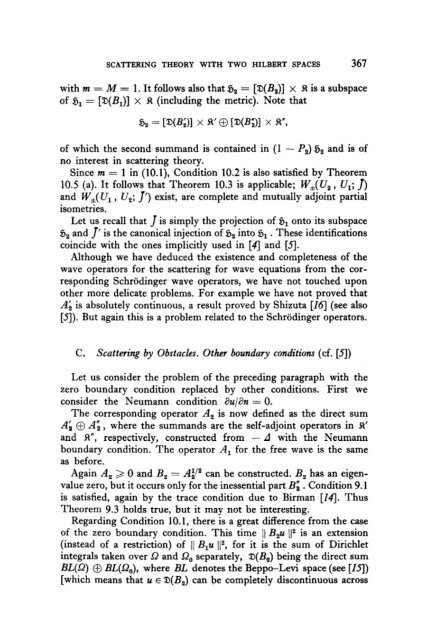On the Characters and the Plancherel Formula of Nilpotent Groups ...
On the Characters and the Plancherel Formula of Nilpotent Groups ...
On the Characters and the Plancherel Formula of Nilpotent Groups ...
You also want an ePaper? Increase the reach of your titles
YUMPU automatically turns print PDFs into web optimized ePapers that Google loves.
SCATTERING THEORY WITH TWO HILBERT SPACES 367<br />
with m = M = 1. It follows also that & = [X$&J] x Jt is a subspace<br />
<strong>of</strong> a1 = [ID( x R (including <strong>the</strong> metric). Note that<br />
<strong>of</strong> which <strong>the</strong> second summ<strong>and</strong> is contained in (1 - P,) $ja <strong>and</strong> is <strong>of</strong><br />
no interest in scattering <strong>the</strong>ory.<br />
Since m = 1 in (lO.l), Condition 10.2 is also satisfied by Theorem<br />
10.5 (a). It follows that Theorem 10.3 is applicable; W,(U, , Ur; J)<br />
<strong>and</strong> W,(U,, U2; Y) exist, are complete <strong>and</strong> mutually adjoint partial<br />
isometries.<br />
Let us recall that J is simply <strong>the</strong> projection <strong>of</strong> 8i onto its subspace<br />
8, <strong>and</strong> J’ is <strong>the</strong> canonical injection <strong>of</strong> 8, into br . These identifications<br />
coincide with <strong>the</strong> ones implicitly used in [4] <strong>and</strong> [.5].<br />
Although we have deduced <strong>the</strong> existence <strong>and</strong> completeness <strong>of</strong> <strong>the</strong><br />
wave operators for <strong>the</strong> scattering for wave equations from <strong>the</strong> cor-<br />
responding Schrodinger wave operators, we have not touched upon<br />
o<strong>the</strong>r more delicate problems. For example we have not proved that<br />
A;1 is absolutely continuous, a result proved by Shizuta [Id] (see also<br />
[5]). But again this is a problem related to <strong>the</strong> SchrSdinger operators.<br />
C. Scattering by Obstacles. O<strong>the</strong>r boundary conditions (cf. [5J)<br />
Let us consider <strong>the</strong> problem <strong>of</strong> <strong>the</strong> preceding paragraph with <strong>the</strong><br />
zero boundary condition replaced by o<strong>the</strong>r conditions. First we<br />
consider <strong>the</strong> Neumann condition a~/& = 0.<br />
The corresponding operator A, is now defined as <strong>the</strong> direct sum<br />
$4 @A”,, where <strong>the</strong> summ<strong>and</strong>s are <strong>the</strong> self-adjoint operators in Ji’<br />
<strong>and</strong> R”, respectively, constructed from - d with <strong>the</strong> Neumann<br />
boundary condition. The operator A, for <strong>the</strong> free wave is <strong>the</strong> same<br />
as before.<br />
Again A, 3 0 <strong>and</strong> B, = Ai/” can be constructed. B, has an eigenvalue<br />
zero, but it occurs only for <strong>the</strong> inessential part B”, . Condition 9.1<br />
is satisfied, again by <strong>the</strong> trace condition due to Birman [Z4]. Thus<br />
Theorem 9.3 holds true, but it may not be interesting.<br />
Regarding Condition 10.1, <strong>the</strong>re is a great difference from <strong>the</strong> case<br />
<strong>of</strong> <strong>the</strong> zero boundary condition. This time 1) B,u II2 is an extension<br />
(instead <strong>of</strong> a restriction) <strong>of</strong> Ij B,u 112, for it is <strong>the</strong> sum <strong>of</strong> Dirichlet<br />
integrals taken over Q <strong>and</strong> Sz, separately, D(B,) being <strong>the</strong> direct sum<br />
WQ) 0 BL(Q,,), w h ere BL denotes <strong>the</strong> Beppo-Levi space (see [15J)<br />
[which means that u E D(B,) can be completely discontinuous across

















